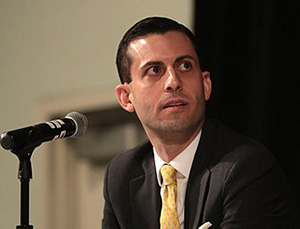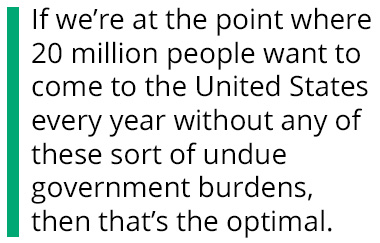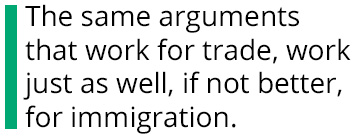 For Ideaspace’s Strategic Inquiry No. 2, we asked a number of leading thinkers on immigration policy two simple questions: How many immigrants should the U.S. government allow to enter the country every year? And how should the federal government arrive at that number? The answers were not so simple and ranged exuberantly across the political spectrum.
For Ideaspace’s Strategic Inquiry No. 2, we asked a number of leading thinkers on immigration policy two simple questions: How many immigrants should the U.S. government allow to enter the country every year? And how should the federal government arrive at that number? The answers were not so simple and ranged exuberantly across the political spectrum.
One of our opinion leaders, Alex Nowrasteh, Director of Immigration Studies at Cato, holds a libertarian viewpoint when it comes to immigration policy. Libertarians often side with conservatives on economic issues in arguing against an activist role for government in building a fair and equitable society. In matters of immigration, however, our conversation with Nowrasteh reveals how that hands-off dictum can foster an alliance between libertarians and some far-left progressives who favor a more open immigration system.
 Here is a glimpse of where Nowrasteh’s thinking takes him: “Let’s say it’s 500 million more people [who choose to move to the U.S. over the next 10 years] with a 70-percent labor force participation rate, working, spending money, paying taxes, using public services and public goods. Yeah, absolutely the system can handle that.”
Here is a glimpse of where Nowrasteh’s thinking takes him: “Let’s say it’s 500 million more people [who choose to move to the U.S. over the next 10 years] with a 70-percent labor force participation rate, working, spending money, paying taxes, using public services and public goods. Yeah, absolutely the system can handle that.”
Here, our full interview with Nowrasteh, which has been lightly edited for clarity.
Ideaspace: In the debate over legal immigration, rarely does the discussion actually center on a number. If you don’t have a number, per se, can you tell us what considerations the country should make, or what calculus we should use to arrive at an optimal number?
Alex Nowrasteh: I think the optimal number can only be determined by the free market and the voluntary mutually beneficial interactions that people have with each other, either through marriage or having children or through hiring or starting a business. So my base way of viewing immigration is that everything should be allowed, unless there’s a really good reason not to allow it. Those reasons being that immigrants could harm the life, liberty, or private property of people who are living here, or there’s a very high probability, in which case you block those individual immigrants.
So my view is limited government, individual liberty, having the smallest government footprint on this issue possible to maximize individual freedom of both Americans and immigrants. So that number is not something that a government bureaucrat or a politician or a social planner can tell you, because what is optimal for the United States depends on the decisions made by Americans individually and by immigrants overseas. So it would be impossible for me to tell you that number.
I: That sentiment falls in line with what Mark Krikorian [executive director of the Center for Immigration Studies] told us. He thinks the debate is binary: that you’re either for zero immigration with exceptions, or, if you’re pro-immigration, you’re really for limitless immigration, with exceptions. He sees no gray area.
AN: Well, what I’m really saying is that the government should not be the ones to set the limits, but that the limits are determined through social interactions, through the markets. So if there’s no benefit to come into the United States, people aren’t going to come. And if we’re at that point, then that’s the optimal. If we’re at the point where 20 million people want to come to the United States every year without any of these sort of undue government burdens, then that’s the optimal. But I don’t have the hubris to plan, to be a social central planner to basically say what is the ideal for American society. And frankly, anybody who pretends to be that is making the same error made, I think, by central planners throughout history. I could never tell you a number, right? I think anybody who does, doesn’t know what they’re talking about, doesn’t understand how humans make decisions in systems.
I: Then I have two questions inspired by those ideas. One would be, let’s say that market forces and individuals making personal choices result in another 500 million people wanting to come to the country. Does the country have the capacity to accept those people? Do we have the infrastructure? Do we have the wherewithal, whether it be social services, housing stock, et cetera?
AN: Absolutely. I mean, the thing is like, let’s say those numbers, large numbers of people were to come every year. Not 500 million in one year, right? But let’s say the number builds up, like 500 million over the next 10 years.
What will happen immediately is the price of housing will rise in the United States. That will stimulate more housing construction in the United States. Wages would adjust in the United States, both going up and going down for some different workers. These immigrants who come will be taxpayers, people, businessmen, investors, consumers, everybody will change their behavior a little bit due to this expected increase in the population, such that the economy can adjust pretty easily.
And the issue with infrastructure; the worst thing you can do with infrastructure is have fewer people using it because that’s what we had in New York in the ’70s, when the population declined. So people aren’t just consumers of infrastructure, they’re also taxpayers who use the infrastructure. So you have, let’s say 500 million more people with a 70-percent labor force participation rate, working, spending money, paying taxes, using public services and public goods. Yeah, absolutely the system can handle that. A free-market system is basically the best thing to handle such an influx of people. That’s one of the best things it does is it handles pretty quickly massive increases in demand for goods and services.
I: The second question in reaction to your ideas is, If the federal government suddenly said, “Okay, let’s have no caps, no limits to immigration whatsoever,” do you have any guess as to how many people would choose to immigrate to the country in the year 2021, and then over the next five years?
AN: So that’s always difficult to try to do. I think immediately you would have everybody who’s in the green card backlog come in the first year. Plus, just building in some room, maybe three times as many. So, I mean, that’s just an educated guess, right? But that would be somewhere around 10 to 15 million, I think, in the first year. And then I think it would slow down a little bit after maybe one or two years of that, and then it would build up to probably 20 million consistently every year.

The thing to remember, though, is that these immigrants aren’t just people who come and stay here forever. A lot of them would come for a year or two, make some money, go back home. So maybe only half of those people would stay permanently. The rest would be temporary migrants. It could be a lot more than half are temporary workers, like we saw with Mexico from 1965 to 1986; we saw about 80 percent of Mexican migrants return home then. They just came to work seasonally. So it could be one of these things, where a lot of people, because of cheap international air travel, they want to come here and make three, four, five, 10 times as much money as they could in their home countries, and then return back home with a big pot of money.
And I think that is something that we just underrate, but that’s been true of immigration for a long time. A majority of Italian immigrants to the U.S. returned to Italy during the Age of Migration. About half of British immigrants in the late 19th century returned home. So I think that if we transitioned to an open immigration policy, there’d be large inflows, but the inflows of people who would permanently settle in the United States would be a small fraction of the total number.
So I guess I’m kind of speeding into Mark Krikorian’s stereotype a little bit, although I’m not a left winger.
I: Do you foresee any sort of regulatory system for the type of wide-open immigration policy you’re describing?
AN: I think that there should be restrictions on people who have committed serious violent and property offenses in their home countries. People who we have a justification to believe are either a national security threat or a criminal threat. So if you think they are spies for China or they spent a mysterious amount of time at a camp in Afghanistan, something like that, or if people have a serious communicable disease.
I: So then you are falling right into Mark Krikorian’s characterization of the left’s stance on immigration, even though you’re not a lefty. With the issue of immigration, at least, there appears to be a natural overlap with libertarians and liberals.
AN: It’s one of these things. My background’s in economics. One of the things that economists who are on the left, on the right, on the center, just about all of them believe that free trade is good. And the same logic, the same arguments that work for trade, work just as well, if not better, for immigration. The economically optimal immigration system is free immigration. There are different issues, like if you import a bunch of steel from China, that steel’s not going to potentially commit a crime. It’s not going to cause annoyance because it doesn’t speak English, but the economics are clear-cut.
I: You’ve debated Mark Krikorian a number of times. You have the opposite view of him. How do you debunk his charge that immigration at current levels is a net loss for America?
AN: My argument is if you take a look at the net fiscal impact studies that are out there, immigrants, on average, contribute more in taxes than they take in benefits. And there’s a whole lot of complicated reasons why that is, but that’s generally the case. But even so, if you think that immigrants consume more benefits, then that I think is a great argument for reducing benefit levels for immigrants, at least until they naturalize rather than cutting off immigration, right? If welfare is his problem, then he should be against welfare, not against the presence of the people who are using it.
My issue is if you take a look at the budget in the U.S. government, tinkering with demographics by changing immigration flow doesn’t really affect much of anything. Immigrants are a net positive, but not by very much. But it turns out the thing that actually does affect the fiscal state of the U.S. government is tax and spending policy. So if you actually want to fix that problem and are worried about deficits, you don’t tinker with demographics through immigration, you change the tax and spending system.
With immigration, you’re not going to solve the budget deficit by changing the immigration system, but you’re also not going to dramatically add to it either.
I: And closing off legal immigration is only going to increase illegal immigration. You just end up with a bigger undocumented population.
AN: Yes. And that has other interesting system effects because undocumented immigrants have about zero access to means-tested welfare benefits in the United States, but their wages are also lower because they’re unauthorized because it’s risky for employers to hire them because of immigration enforcement. So employers compensate themselves for the risk by paying a little bit less than they otherwise would. By the same token, the undocumented do pay a little bit less in taxes. They’re more likely to get paid under the table, but not by that much. Anyway, they’re often low-skilled, so it’s not like they’re going to pay high taxes regardless.
The thing with Social Security, for instance, is that a lot of undocumented immigrants do pay in. They pay about $12 billion a year into the system, and they have no recourse to get those benefits. And Social Security is running an enormous deficit. So funny enough, immigration reduces the long-term deficit of Social Security and Medicare. If you follow Mark Krikorian’s course, it makes things a bit worse in the long run.
I: How does an undocumented immigrant working under the table pay into Social Security?
AN: If they’re working under the table, they don’t. But if they’re working, say, on somebody else’s Social Security number, then they’re paying in that way.
I: How much of the undocumented population is working in that fashion, where they’re paying into Social Security?
AN: There are various estimates, but they’re generally between 55 and 75 percent.
I: This really challenges Mark Krikorian’s claims, and conservative claims, that immigrants are a net loss for America.
 AN: Yes, and with Mark Krikorian, I think his main thing is he’s a nationalist, and he thinks that today’s immigrants and their kids are just not going to assimilate to American culture and society as much as previous immigration waves did. They’re not going to be as patriotic. They’re not going to love America as much. And related to this is they’re not going to vote Republican as much as Mark wants them to. And so if that were different, if immigrants were say, 90 percent, or let’s say 80 percent Republican and Mark was guaranteed that their levels of patriotism would be acceptable to him, I think he’d probably change.
AN: Yes, and with Mark Krikorian, I think his main thing is he’s a nationalist, and he thinks that today’s immigrants and their kids are just not going to assimilate to American culture and society as much as previous immigration waves did. They’re not going to be as patriotic. They’re not going to love America as much. And related to this is they’re not going to vote Republican as much as Mark wants them to. And so if that were different, if immigrants were say, 90 percent, or let’s say 80 percent Republican and Mark was guaranteed that their levels of patriotism would be acceptable to him, I think he’d probably change.
I: Has immigration always been this partisan?
AN: I’ve been debating Mark for like 12 years now. And a long time ago he would say, “Oh, immigration isn’t really a partisan issue.” He’d say that he’s a conservative, and Alex is a libertarian, and they’re liberals and they hold all different types of positions, but it’s definitely become a major partisan issue with huge disagreements in the last eight years or so. And that’s, I think, partly due to some of the work that Mark has been doing.
I: Do you feel Mark’s organization had a big role in the failure of the 2013 bill?
AN: I think the entirety of the John Tanton network [Center for Immigration Studies, NumbersUSA, Federation for American Immigration Reform] played a role in promoting this very nativist nonsense.
Read More:

Strategic Inquiry No. 2


